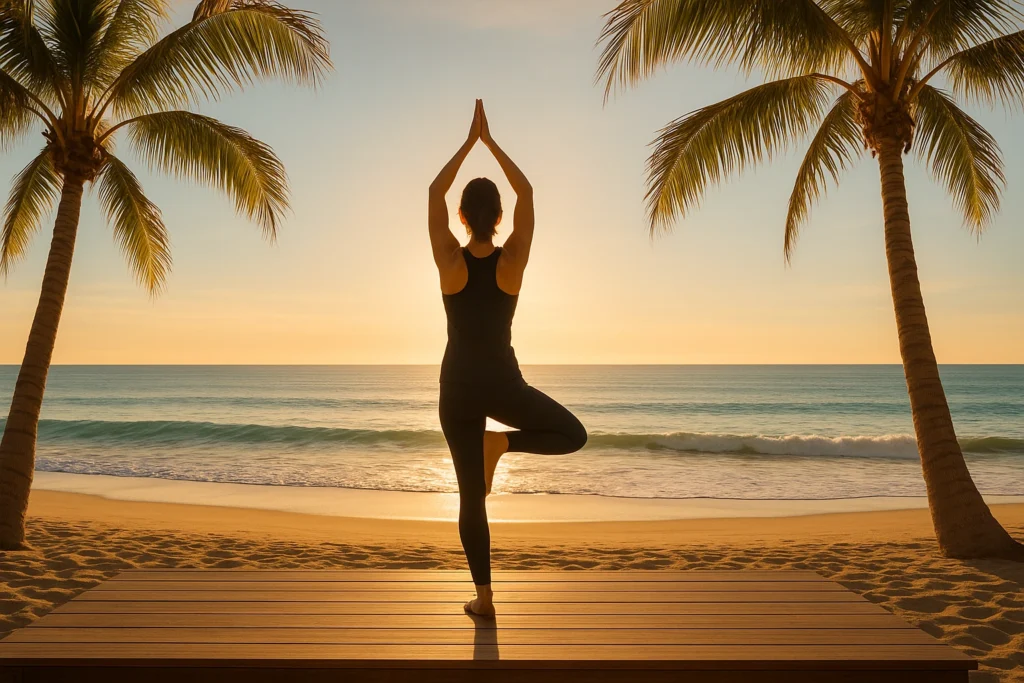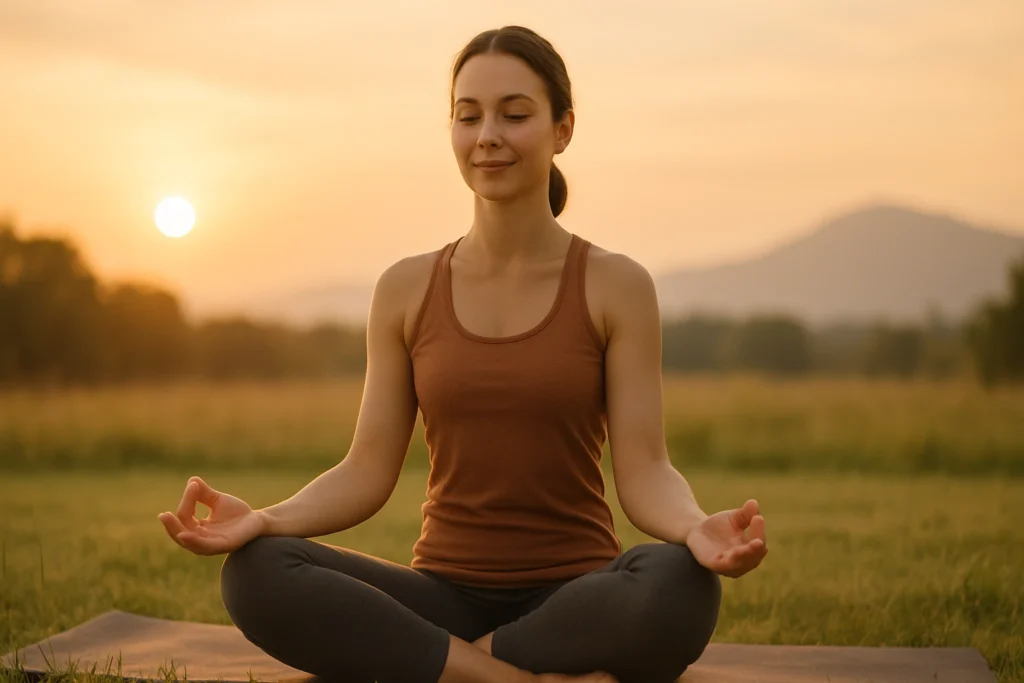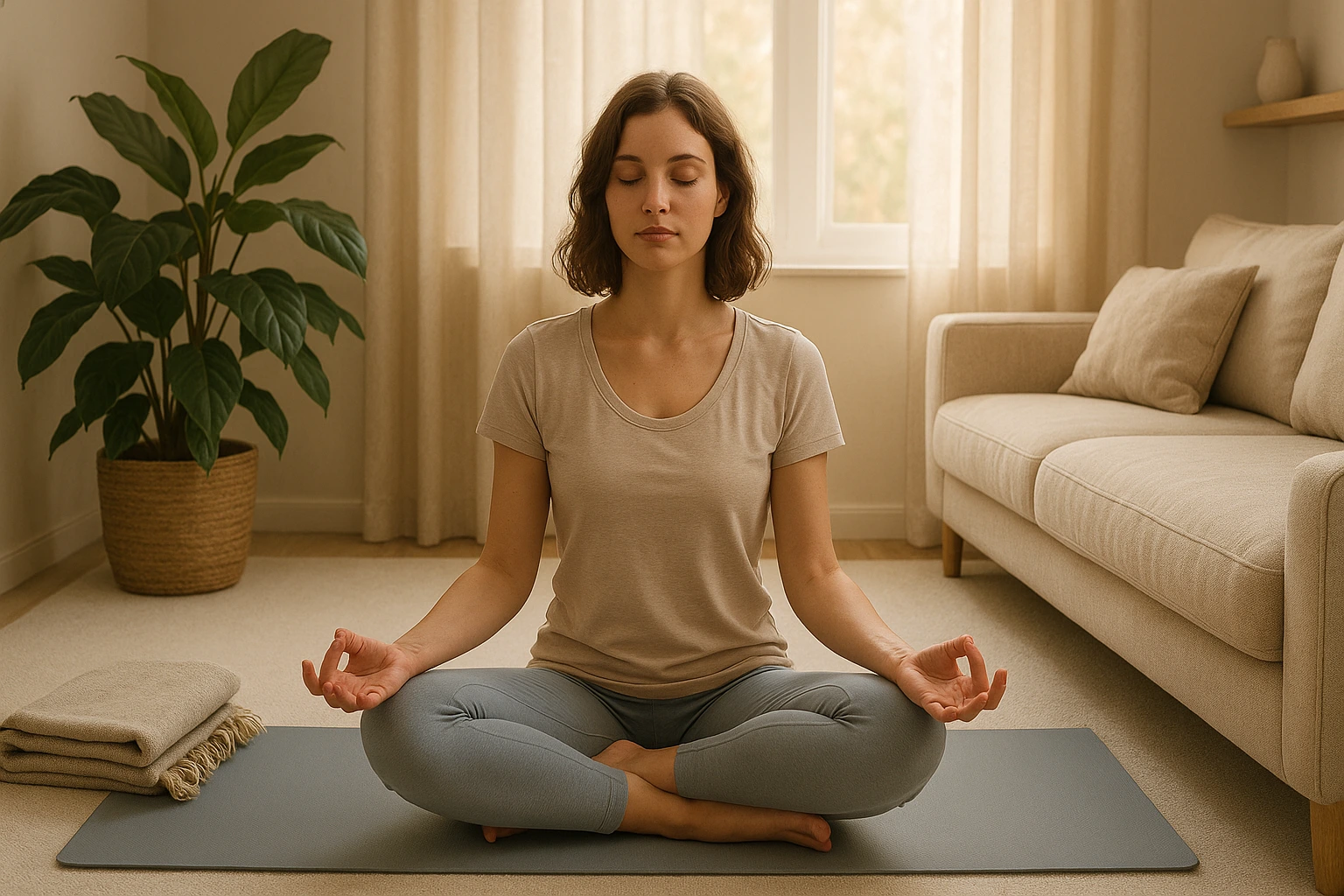
Feeling frazzled after a chaotic day? Unroll your yoga mat, take a deep breath, and let yoga for stress relief take the edge off. Lots of people feel stressed every day—but you don’t have to live there. With a few simple poses and some breathwork, 15 minutes is enough to feel calmer, even if you’re brand-new. This guide walks you through friendly, beginner steps. Curious about a bigger picture for managing stress with breath and movement? Explore our comprehensive approach to mindfulness stress relief to see how yoga fits in. Ready to feel more grounded? Let’s begin!
Start Your Stress Relief JourneyTable of Contents
- Key Takeaways for Your Yoga Practice
- Understanding Stress and Its Impact
- Why Calming Yoga Works
- Gentle Poses to Unwind
- Breathing Exercises to Unwind
- Creating Your Relaxation Yoga Routine
- Staying Consistent with Your Practice
- Beyond the Mat: Holistic Calm
- Interactive Stress Check-In
- Final Thoughts: Let Yoga Be Your Stress Fix
Key Takeaways for Your Yoga Practice
- Yoga and breathwork are approachable ways to ease stress and support relaxation.
- Gentle poses like Child’s Pose and Legs-up-the-Wall help your body shift toward calm.
- Breathwork, like diaphragmatic breathing, may soothe anxiety and support emotional balance.
- Consistency matters: even 5–10 minutes a day can make a difference.
- Always tune in to your body and adjust poses to feel good.
- Breathwork is a simple tool you can use anytime to settle your system.
Interactive Stress Check-In
How stressed are you feeling right now? Use this quick tool to check in with yourself and get personalized yoga and breathwork recommendations to help you unwind.
Recommended Practices
Understanding Stress and Its Impact
Before we get into how yoga can help, take a moment to notice what stress does in everyday life. It’s your body’s built-in reaction to demands—think deadlines, family logistics, or money worries. A little stress can nudge you to act, but when it sticks around, it wears you down.
Common Symptoms of Stress
- Headaches
- Muscle tension
- Fatigue
- Difficulty sleeping
- Irritability
- Anxiety
- Digestive problems
- Difficulty concentrating
Long-Term Risks of Chronic Stress
If unmanaged, chronic stress can contribute to serious conditions, such as:
- Heart disease
- High blood pressure
- Weakened immune system
- Depression
- Anxiety disorders
That’s why simple tools—gentle yoga and meditation—are worth keeping on hand. Curious about taking your practice to a serene destination? Check out how to plan a yoga retreat in Baja, Mexico for ultimate relaxation. Next, let’s see how these techniques can help.
This post has affiliate links. We may earn a commission. Learn more.
“The mind is everything. What you think you become.” – Buddha
Why Yoga for Stress Relief Works
Yoga is more than stretching—it’s a practice that weaves together poses (asanas), breathwork (pranayama), and short periods of meditation. Think of it as a small reset for body and mind. Research—including summaries from Harvard Health—suggests yoga may help lower stress hormones and support mental well-being.
How Yoga Helps You De-Stress
- May lower cortisol: Some studies link yoga with reductions in the stress hormone cortisol.
- May increase GABA: Small studies suggest yoga/meditation can be associated with higher GABA levels.
- Encourages relaxation: Certain practices can help activate the body’s relaxation response.
- Sharpens body awareness: Yoga helps you notice and release areas of tension.
- Builds mindfulness: It keeps you in the moment, quieting racing thoughts.
Now that you see why yoga is a helpful tool for calming the nervous system, let’s check out some easy poses to get you started. For more on how yoga enhances mindfulness, see our guide on the benefits of mindful movement.
Yoga for Stress Relief: Gentle Poses
If you’re using yoga to take the edge off, these beginner-friendly poses are a good place to start. Adjust them to your body, skip anything that pinches, and move at a pace that feels kind. Try these five simple shapes.
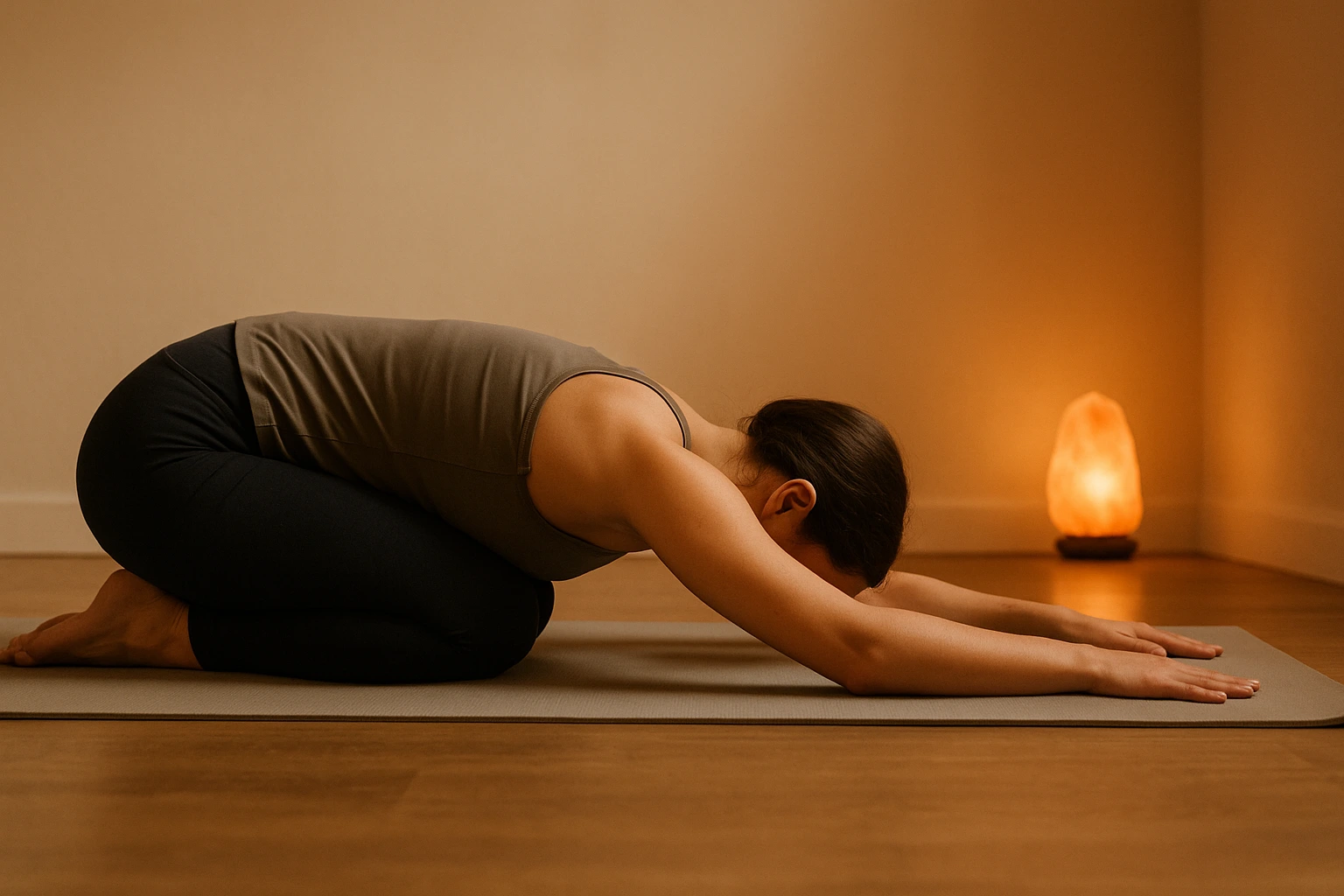
Child’s Pose: A Go-To for Easing Tension
This steady, restful shape gently opens the hips and back and can take weight off the shoulders—especially when the day’s been heavy.
- Here’s how: Kneel with knees hip-width apart. Sit back on heels. Breathe out, gently fold forward, and let your forehead rest on the ground. Extend arms forward or rest them by your sides. Hold for 5-10 breaths.
Legs-up-the-Wall: Restorative Yoga
This pose may help activate the relaxation response and ease anxious feelings by improving blood flow—great for finding calm.
- Here’s how: Set up with one hip at the wall, then lie back and send your legs up. Scoot your hips to a comfortable spot. Rest your arms by your sides, palms up. Stay for 5–15 minutes.
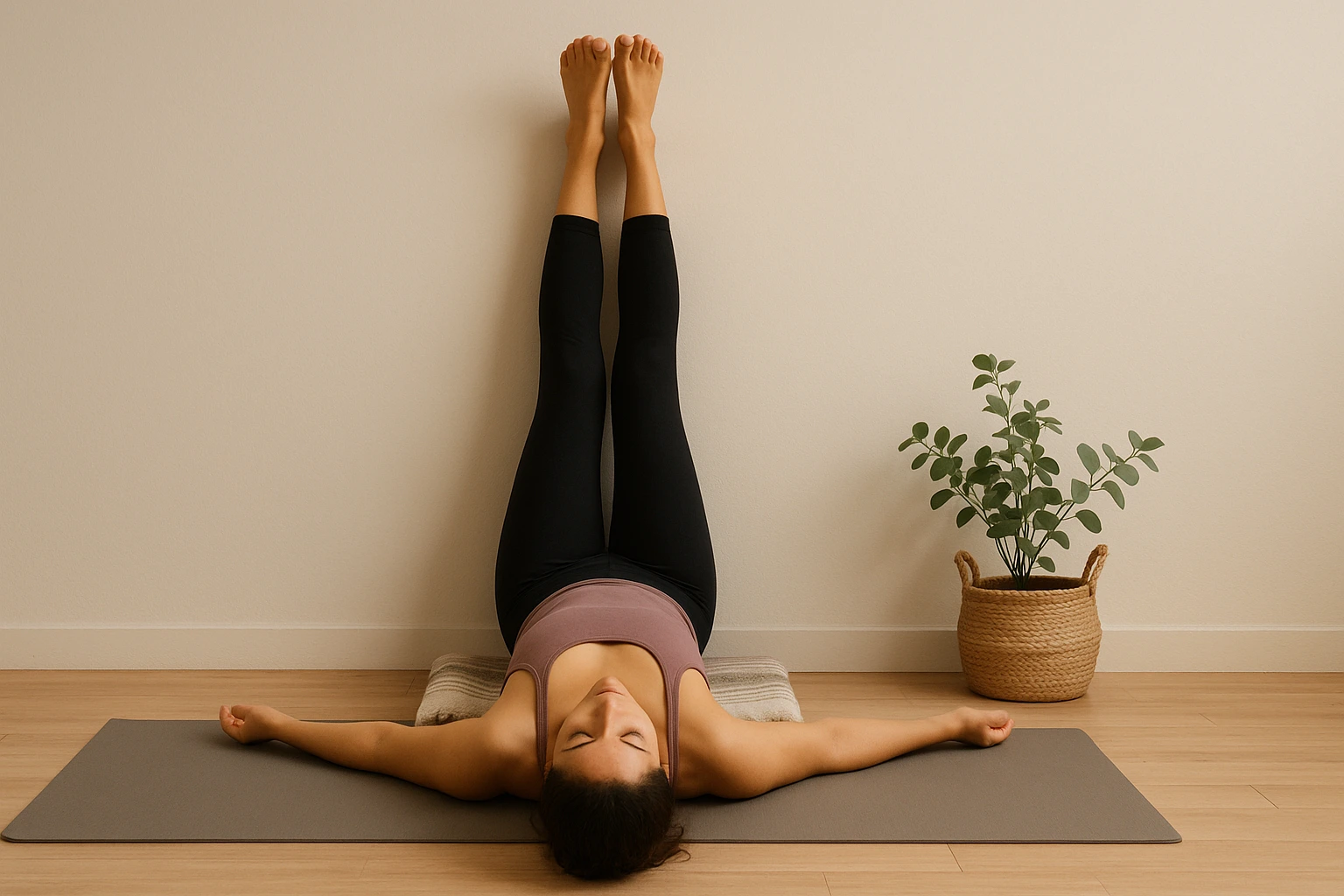
Cat-Cow Pose: Dynamic Stress Relief
This gentle flow warms you up, loosens the spine, and can help steady the mind for a more even mood.
- Here’s how: Start on hands and knees, hands under shoulders, knees under hips. Inhale, arch your back, dropping belly to the floor (Cow). Exhale, round spine to the ceiling, tucking chin (Cat). Repeat for 5-10 breaths.
Forward Fold: Calming Yoga Pose
This pose stretches your hamstrings and back and can feel instantly soothing when you need a reset.
- Here’s how: Stand with feet hip-width apart. Exhale, hinge from your hips, and let your head hang heavy. Bend your knees a touch if that feels better. Hold for 5-10 breaths.
Corpse Pose: Deep Relaxation
Savasana helps your body and mind unwind, integrating your practice’s benefits—a must for post-yoga integration.
- Here’s how: Lie flat on your back, legs stretched out, arms resting by your sides, palms up. Close eyes, relax completely, and let go of tension. Hold for 5-15 minutes.
Yoga Pose Cheat Sheet
| Pose Name | Benefits | How to Do It |
|---|---|---|
| Child’s Pose | Calming, grounding, gently opens hips and back | Kneel, sit back on heels, fold forward, rest forehead on ground. |
| Legs-up-the-Wall Pose | Supports the nervous system, may ease feelings of anxiety, relieves tired legs and feet | Sit close to a wall, lift legs onto wall, lie back. |
| Cat-Cow Pose | Warms body, improves spinal flexibility, may relieve stress | Start on hands and knees, inhale into Cow (arched back), exhale into Cat (rounded spine). |
| Forward Fold | Stretches hamstrings and spine, may help calm the mind | Stand, exhale, bend forward from hips. |
| Corpse Pose (Savasana) | Deep relaxation that helps integrate the benefits of practice | Lie on back, legs stretched out, arms by sides, palms up. Relax. |
With these poses under your belt, let’s explore breathwork that helps you settle your system even more.
Breathwork for Stress: A Partner to Yoga
Breathwork (pranayama) is simply paying attention to—and shaping—your breathing. Practicing breathwork for stress can nudge your nervous system toward balance. It pairs well with mindful movement to deepen relaxation, and different patterns can either settle you or give you a light lift.

Diaphragmatic Breathing for Calm
This steady belly-breath helps many people shift out of “fight or flight.”
- Here’s how: Lie on your back with knees bent and feet flat. Rest one hand on your chest and the other on your belly. Inhale through your nose so your belly rises more than your chest; exhale slowly through your mouth. Continue for 5–10 minutes.
Alternate Nostril Breathing: Balancing Calm
This traditional technique is used to promote a sense of balance and calm.
- Here’s how: Sit upright. Close your right nostril with your thumb and inhale left. Close the left with your ring finger, exhale right. Inhale right, close it, exhale left. Keep an easy pace for 5–10 minutes.
Box Breathing: Simple Stress Relief
Think of it as a steady 4-by-4 rhythm that many people find settling.
- Here’s how: Sit comfortably and exhale fully. Inhale through your nose for 4, hold for 4, exhale through your mouth for 4, hold for 4. Repeat the “box” for 5–10 minutes.
Lion’s Breath: Energizing Stress Relief
This playful breath releases tension and may help you feel more energized.
- Here’s how: Kneel, palms on knees. Inhale deeply through the nose. Exhale with a strong “ha,” open your mouth wide, and stick out your tongue. Repeat several times.
Breathwork Cheat Sheet
| Technique | Benefits | How to Do It |
|---|---|---|
| Diaphragmatic Breathing | May reduce stress and anxiety; promotes relaxation | Lie on back, hand on chest and belly. Inhale, belly expands. Exhale slowly. |
| Alternate Nostril | Promotes a sense of balance and calm | Sit, close right nostril, inhale left. Close left, exhale right. Alternate. |
| Box Breathing | Can calm the mind and ease stress | Exhale, inhale for 4, hold for 4, exhale for 4, hold for 4. Repeat. |
| Lion’s Breath | Releases tension; may feel energizing | Kneel, inhale deeply. Exhale with “ha,” tongue out. |
Disclaimer: Consult a doctor before practicing if you have respiratory or medical conditions. Next, let’s combine these techniques into a stress-busting routine.
Creating Your Yoga for Stress Relief Routine
Now that you’ve tried a few poses and breaths, let’s shape a routine. Start small, stay consistent—that’s where the calm really stacks up.
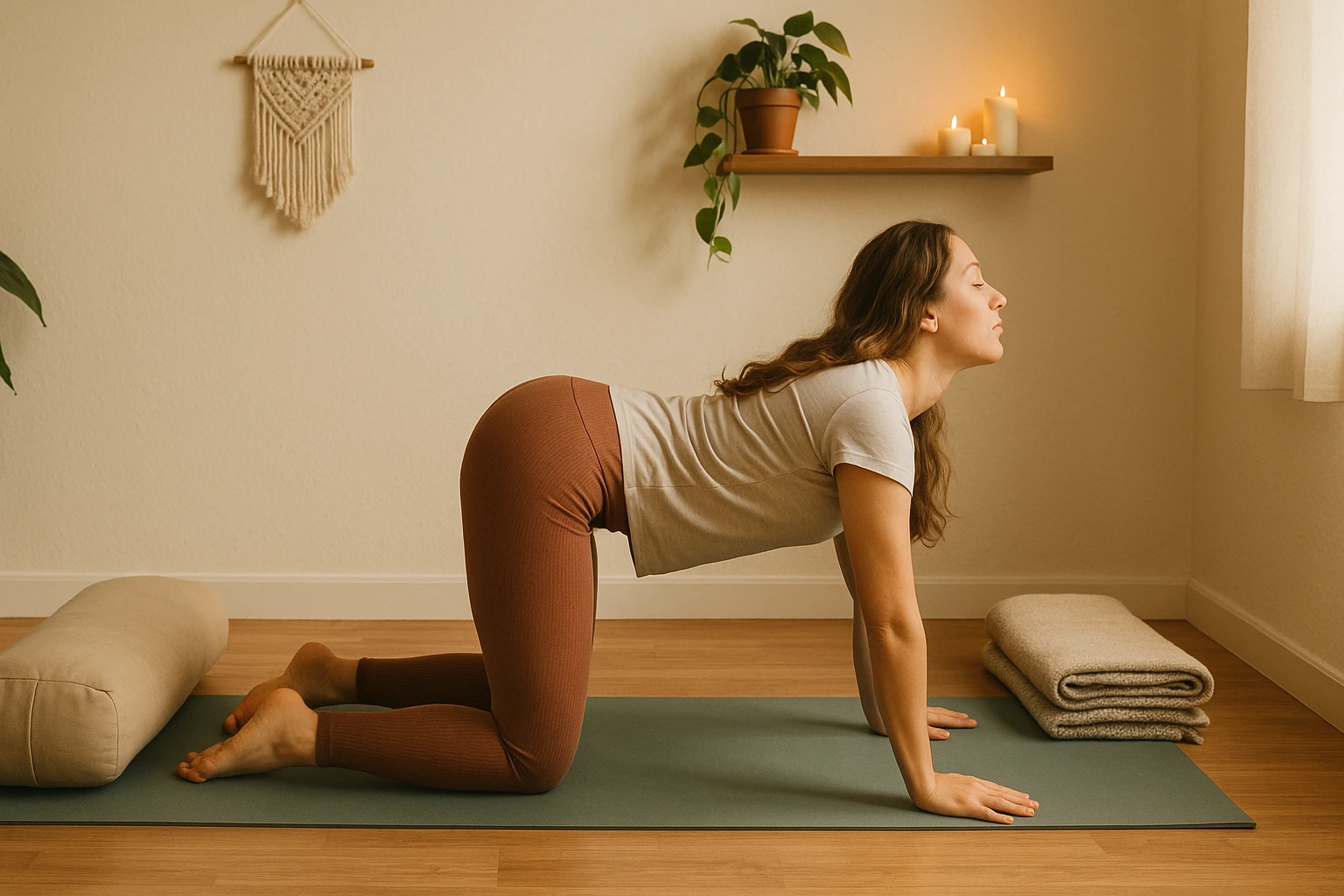
Tips for Building Your Routine
- Pick a time: Anchor it to something you already do (after coffee, before bed).
- Buddy up: A quick text check-in with a friend keeps you honest.
- Set up your spot: Keep your mat out and props handy so there’s less friction.
- Reward small wins: Celebrate a week of steady practice.
- Be kind to yourself: Missed a day? No drama—start again at the next chance.
- Combine techniques: Pair breathwork for stress with poses, like diaphragmatic breathing in Child’s Pose, for mind-soothing habits.
Beginner Routine for Yoga for Stress Relief
- Centering (2 min): Sit comfortably, close eyes, and take deep breaths to calm your mind.
- Cat-Cow Pose (3 min): Do 5-10 rounds to warm up and flex the spine.
- Child’s Pose (3 min): Hold for 5-10 breaths to relax.
- Legs-up-the-Wall Pose (3 min): Hold for 5-10 breaths to ease anxious feelings.
- Savasana (4 min): Lie flat, relax, and focus on your breath.
If poor sleep is part of your stress loop, consider an at-home sleep & stress test.
Intermediate Routine for Stress Relief
- Centering with Box Breathing (3 min): Sit and practice box breathing.
- Cat-Cow Pose (3 min): Perform 8-12 rounds.
- Forward Fold (3 min): Hold for 8-12 breaths, bending knees if needed.
- Legs-up-the-Wall Pose (4 min): Hold with diaphragmatic breathing.
- Savasana with Alternate Nostril Breathing (7 min): Lie flat, practice breathwork, then relax.
These routines are approachable if you’re looking to unwind with yoga. If you want to practice without any props, check out our no-equipment yoga routine for more simple options. Ready to make yoga a habit? Let’s talk about sticking with it.
Staying Consistent with Your Practice
Consistency is where the shift happens. A few ideas to help it stick:
- Pick a time: Choose a daily slot and stick to it.
- Buddy up: Pair with a pal for accountability.
- Set up your spot: Keep your mat ready in a quiet corner.
- Reward small wins: Mark a week of steady practice.
- Be gentle: If you miss a day, just begin again.
“You should sit in meditation for 20 minutes every day—unless you’re too busy; then you should sit for an hour.” – Zen saying
Now, let’s take stress relief beyond the mat.
Beyond the Mat: Holistic Stress Relief
A calming yoga practice helps, and everyday habits can multiply the effect. Try these to support body and mind:
- Prioritize sleep: Aim for 7–8 hours most nights to recharge.
- Eat well: Choose whole, colorful foods to stay nourished.
- Keep moving: Regular activity can lift your mood.
- Go outside: A short walk in nature can reset your nerves.
- Stay connected: Time with friends or family often eases worry.
- Practice presence: Simple mindfulness can quiet mental noise.
- Hold boundaries: Kindly say no to energy drains.
- Seek support: If stress feels overwhelming, consider talking with a therapist.
These habits pair beautifully with calming yoga and mindfulness, giving you a balanced way to tackle stress.
Frequently Asked Questions
Final Thoughts: Let Yoga Be Your Stress Fix
Both yoga and breathwork for stress can support your emotional well-being. Start with the beginner routine, tweak it to fit your needs, and take it one step at a time. You may notice tension ease over time. Which pose or breathing technique are you eager to try? Let us know! You’ve got this!

